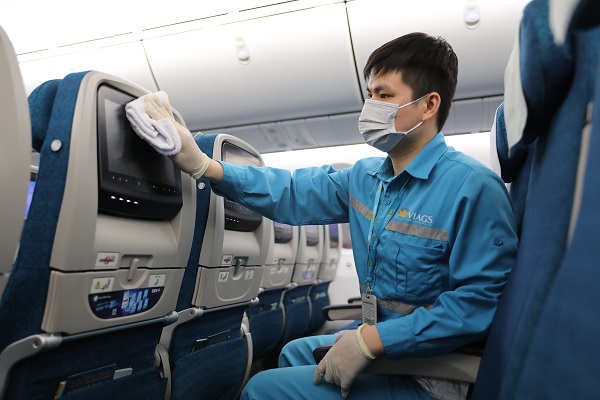
Through the window of Noi Bai Airport, each plane rolls into the parking lot, in a short time, the interior space will be cleaned to start welcoming passengers on a new journey.
However, few people know that, to have a quick, punctual flight, cleaning staff had to " spray water" in airline cleaning with responsibility and dedication to bring the best quality service.
The plane stopped after landing and turning around for only 35 minutes. Therefore, the employees working on aircraft cleaning only have 10 minutes to coordinate and work to ensure cleanliness.
Not only cleaning staff, flight attendants also directly participate in collecting garbage, cleaning the toilet area every 10 minutes, contributing to reducing 70-80% of surface waste during flight operations.

Coach Nguyen Thuy Linh, Team 6 of the Vietnam Airlines Coaches' Team, said that the cleaning of the plane is carried out throughout each period of the flight, including: on the flight, before landing and after passengers leave the plane.
After the last passenger left the plane, the flight attendant quickly checked the entire passenger compartment, noted the areas that need special hygiene to notify and share information for the ground hygiene team to shorten cleaning time, on average, only about 8-10 minutes/trip. In some cases, flight attendants can support garbage collection in the seat area to optimize the time to turn the plane.
The flight attendant is always flexible, coordinating quickly with the aircraft cleaning team and related units to optimize time. Aircraft cleaning is not simply a responsibility but also a dedication, just like the way each person maintains their own home, the female flight attendant shared.
On the ground, the aircraft cleaning staff will quickly start cleaning up according to the strict lists, processes, and standards of Vietnam Airlines.
Ms. Vu Thi Phuong, the On-Ship Service Team (VIAGS, a member unit of VNA) said that each aircraft will have a cleaning team of 6 people (small-body aircraft such as A320, A321) and 14 people ( Long-body aircraft including A350, B787) to carry out work at many interior locations in the aircraft such as: kitchen area, floor vacuum cleaner, toilets, garbage collection, etc.
"A plane cleaning needs to be meticulous and careful but must be clean to ensure the return time of flights, helping passengers on the next routes to have the most punctual and comfortable flights," said Ms. Phuong.
According to Mr. Le Hoai Ninh, the On-Ship Service Team, VIAGS Parking lot Service Center, when passengers get off late, the time for cleaning the plane is even shortened. In this situation, the service group was forced to speed up to complete the work. If the workload is too large, the on-duty staff will mobilize additional support personnel.
For long-haul flights with more waste, the crew must control the situation and evaluate the workload to coordinate quickly and accurately to ensure the aircraft returns on time.
Before each flight has a short take-off time, the monitoring team will check and determine how much time is needed to shorten the flight. If the requirement is higher than the standard, the cleaning team needs to add more people to ensure progress. Thanks to their agility and effective coordination, ground service departments can complete the work on schedule, helping the flight depart on schedule, Mr. Ninh determined.
Ms. Tran Thanh Ha, Deputy Head of the above Service Department, did not say that the development of process standards involves many units for implementation. In particular, the standards must comply with all general regulations, as well as ensure the operating time and hygiene requirements for passengers traveling on the plane.
According to Ms. Ha, at Vietnam Airlines, aircraft cleaning is implemented in many levels, from basic to intensive, suitable for each operating stage of the aircraft, including: hygiene on flights while flying; hygiene after flight when the plane lands; Hygiene at the end of the day when the plane stops at the airport base; Overall hygiene when the aircraft stops at the airport based on an industrial mining and sanitation cycle when the aircraft performs periodic maintenance at the factory.
Vietnam Airlines constantly research and simplify work to minimize service time for departments on the ground and on the flight. When providing meals, it is calculated to limit the amount of garbage generated, helping the waitress clean up faster. In addition, the aircraft cleaning unit also tests tools such as mini vacuum cleaners to handle food debris right on the aircraft instead of waiting until it lands, Ms. Ha shared.











